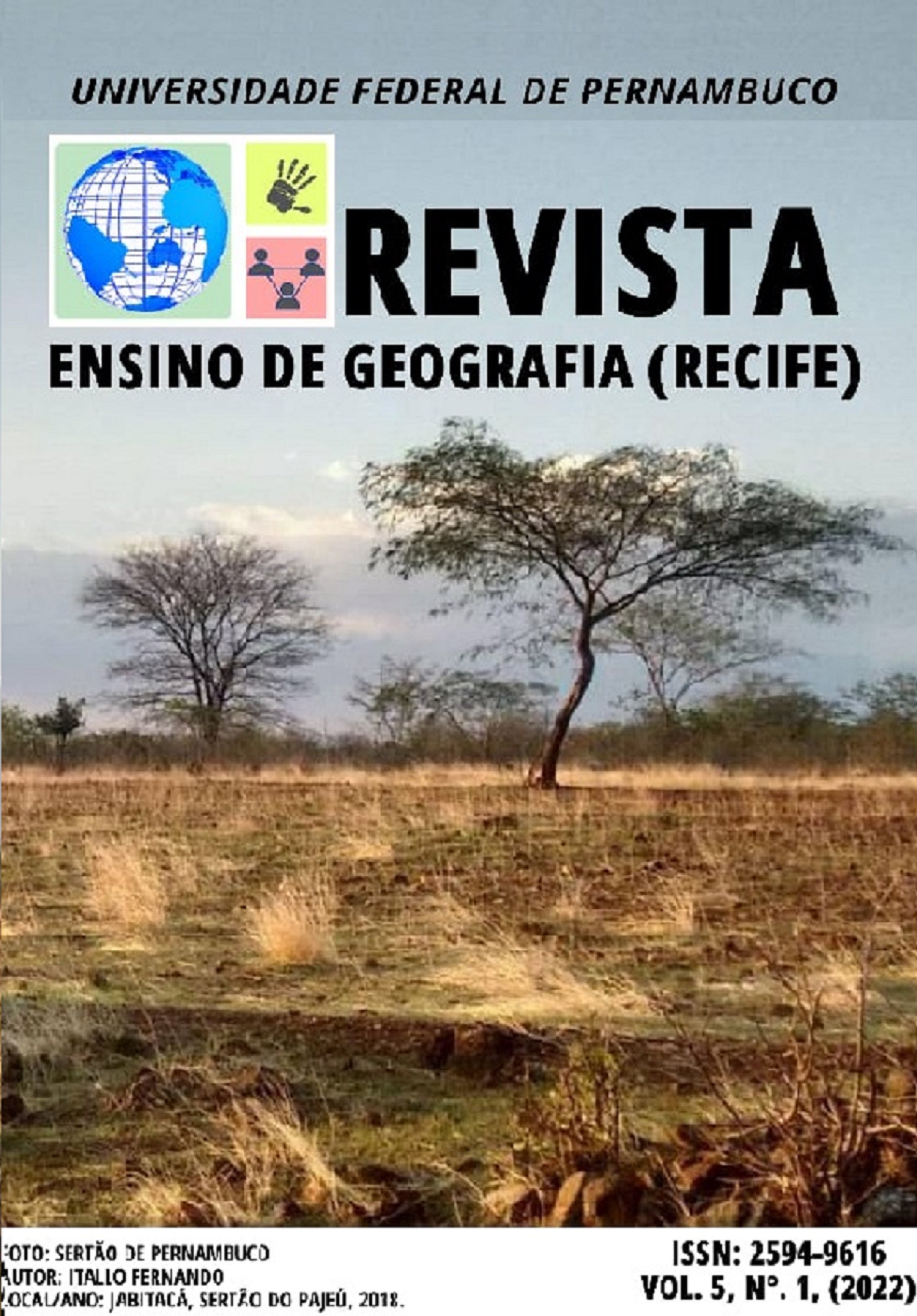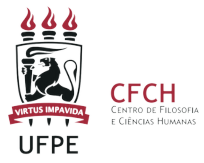collaborative mapping as a cartography teaching strategy: an experience with the canvis application
DOI:
https://doi.org/10.51359/2594-9616.2022.251657Keywords:
VGI, Cartografia Colaborativa, Cartografia Social, Cartografia EscolarAbstract
Given the increased production of Voluntary Geographical Information (VGI) generated by collaborative mapping on online platforms, it is necessary to reflect on the relationship with the teaching of Cartography. This work brings a workshop report with one of the first experiences of the collaborative mapping application Canvis, in teaching Geography. The objective was to indicate places experienced before and during the COVID-19 pandemic. The collaborative mapping was carried out by 42 high school students, who also answered an evaluative questionnaire about the difficulties and potentialities of the methodology, in August 2020. A total of 148 points were mapped within the urban area of Santa Maria, with 57 places that interacted before the pandemic and 91 places that coexist during the pandemic. Students began to experience the territory of nine neighborhoods, which goes against the initial hypothesis that students were more restricted to points in their neighborhoods. It is noticed an increase of points in residential addresses, as well as in hypermarkets, while squares and bars/restaurants are no longer frequented. It is noteworthy that the students indicated the experience with the use of collaborative mapping as positive, mainly because it makes them active subjects in the mapping, although some difficulties in locating it have been highlighted. It is therefore necessary to consider the practice as a two-way street, as by promoting cartographic literacy, it also demands that students have basic notions that allow them to be guided in the collaborative platform, in addition to considering the students' age.
References
ACSELRAD H.; COLI. L. R. Disputas territoriais e disputas cartográficas. In: ACSELRAD H. (Org,). Cartografias sociais e território. Rio de Janeiro: Universidade Federal do Rio de Janeiro, Instituto de Pesquisa e Planejamento Urbano e Regional, 168 p., 2008.
ANTHONY, D.; SMITH, S.W.; WILLIAMSON, T. Reputation and reliability in collective goods the case of the online encyclopedia wikipedia. Rationality and Society, v. 21, p. 283–306, 2009.
AVELLAR, M.; MASCARELLO, C. F. S..; BARBOSA, A. L. de O. Mapas...Por que? Por quem? Para quem? Revista Movimentos Sociais e Dinâmicas Espaciais, Recife, v.7, n.1, p.126-141, 2018.
BATISTA, N. L. Cartografia Escolar, Multimodalidade e Multiletramentos para o ensino de Geografia na Contemporaneidade. 181 f. (Tese de Doutorado). Programa de Pós-Graduação em Geografia. Santa Maria: Universidade Federal de Santa Maria, 2019.
BARTOSCHEK, T.; KEBLER, C. VGI in education: From K-12 to graduate studies. Crowdsourcing Geographic Knowledge; Springer: Berlin, Germany, 2013; pp. 341–360.
BONA, A. S. de; VELHO, L. F.; SILVA, S. L. C. da; PETSCH, C. Matemática em diferentes contextos: um recorte do curso MOOC colaborativo na área da Cartografia. In: FREITAS, P. G. de; MELLO, R. G. (orgs.) Educação em foco: Tecnologias Digitais & Inovação em Práticas de Ensino. Rio de Janeiro: E-Publicar, v. 1, p. 324-344, 2020.
BRAVO, J. V. M.; SLUTER, C. R. . O Mapeamento Colaborativo: seu surgimento, suas características e o funcionamento das plataformas. Revista Brasileira de Geografia Física, v. 11, p. 1902-1916, 2018.
BREDA, T. V. Por que eu tenho que trabalhar lateralidade? Experiências formativas com professoras dos anos iniciais. 289 f. (Tese de Doutorado). Programa de Pós-graduação em Ciência. Campinas: Universidade Estadual de Campinas, Universidade Autónoma de Madrid. 2017.
CANTO, T. S. Práticas de mapeamento com as tecnologias digitais: para pensar a educação cartográfica na contemporaneidade. 116 f. (Tese de Doutorado). Programa de Pós-Graduação em Geografia. São Paulo: Universidade Estadual Paulista, Instituto de Geociências e Ciências Exatas, 2014.
CALLAI, H. C. Aprendendo a ler o mundo: a geografia nos anos iniciais do ensino fundamental. Caderno Cedes, v. 25, n. 66, p. 227-247, 2005.
CHAMBERS, R. Participatory Mapping and Geographic Information Systems: Whose Map? Who is Empowered and Who Disempowered? Who Gains and Who Loses?. The Electronic Journal of Information Systems in Developing Countries, v. 25, p. 1-11, 2006.
DUFFY, W. S. Utilizing Google My Maps in the classroom. Journal of College Academic Support Programs, v. 2, n. 1, p. 59-60, 2019.
EVANGELISTA, A. N. A.; COSTA, J. M.; ROCHA, B. T. G. da.; ALBUQUERQUE, A. M. de; GORAYEB, A.; SANTOS, J. de O. A cartografia e sua aplicação no conhecimento prático de comunidades urbanas vulnerabilizadas. In: GORAYEB, A.; MEIRELES, A. J. de A.;
SILVA, E. V. Cartografia Social e Cidadania experiências de mapeamento participativo dos territórios de comunidades urbanas e tradicionais. Fortaleza: Expressão Gráfica Editora, 2015.
FLANAGIN, A. J.; METZGER, M. J. The credibility of volunteered geographic information. GeoJournal, n.1, v.73, p.137–148, 2008.
GOODCHILD, M. F.; FU, P. RICH, P. Sharing Geographic Information: An Assessment of the Geospatial One-Stop, Annals of the Association of American Geographers, v. 97, n. 2, p. 250-266, 2007.
GORAYEB, A.; MEIRELES, A. J. de A.; SILVA, E. V. Princípios básicos de cartografia e construção de mapas sociais: metodologias aplicadas ao mapeamento participativo. In: GORAYEB, A.; MEIRELES, A. J. de A.; SILVA, E. V. Cartografia Social e Cidadania experiências de mapeamento participativo dos territórios de comunidades urbanas e tradicionais. Fortaleza: Expressão Gráfica Editora, 2015.
HABOWSKI, J. T. V.; ALTERMANN, F. A. O uso de mapeamento colaborativo de graduandos de geografia licenciatura da Universidade Federal de Santa Maria em locais sujeitos a aglomerações. In: PETSCH, C.; DAVID, C.; RIBEIRO, E. A. W.; RIZZATTI, M.; BATISTA, N. L. (Org.). Formação de Professores e Geografia. 1. ed. Araquari: Casa de Hiram, 2021. v. 1. 863p.
HABOWSKI, J. T. V.; PETSCH, C.; SCCOTI, A. A. V. Mapeamento colaborativo como Ferramenta de ensino de Geografia Física por meio dos trabalhos de campo. Anais...IV Colóquio de Pesquisadores em Geografia Física e Ensino de Geografia, p. 67-73, 2019.
LAUDARES, S. Geotecnologias ao alcance de todos. Curitiba: Appris, 2014.
LIMA, E. C. L.; LANDIM NETO, F.; SILVA, E. V. da. O ensino de geografia e a cartografia social: aprendizagem significativa através do mapeamento voltado para a construção da realidade socioambiental. In: GORAYEB, A.; MEIRELES, A. J. de A.; SILVA, E. V. Cartografia Social e Cidadania experiências de mapeamento participativo dos territórios de comunidades urbanas e tradicionais. Fortaleza: Expressão Gráfica Editora, 2015.
LOCH, R. E. N.; FUCKNER, M. A. Panorama do ensino de Cartografia em Santa Catarina: os saberes e as dificuldades dos professores de Geografia. Geosul, v. 20, n. 40, p 105-128, 2005.
MACEDO, D. P. O Ensino de Cartografia e a Formação de Professores: estratégias pós representacionais e a construção do pensamento (geo) espacial. 2018. Mestrado em Geografia. Universidade Federal de Pelotas, 2018.
MENEGUETTE, A. A. C. Cartografia no século 21: revisitando conceitos e definições. Geografia e Pesquisa, v. 6, n. 1, 2012.
NASCIMENTO, D. T. F. Proposals for colaborative mapping as strategies for geography teaching. Geosaberes, Fortaleza, v. 10, n. 22, p. 49 - 61, sep. 2019.
NEIS, P.; ZIELSTRA, D.; ZIPF, A. Comparison of Volunteered Geographic Information Data Contributions and Community Development for Selected World Regions. Future Internet, v. 5, p. 282-300, 2013.
OLIVEIRA, I. J; NASCIMENTO, D. T. F. As geotecnologias e o ensino de cartografia nas escolas: potencialidades e restrições. Revista Brasileira de Educação em Geografia, v. 7, p. 158-172, 2017.
PASSINI, E. Y; CARNEIRO, S. M. M.; NOGUEIRA, V. Contribuições da alfabetização cartográfica na formação da consciência espacial-cidadã. Revista Brasileira de Cartografia, n. 66/4, 741-755, 2014.
PEREIRA, J.; LORISVAL, P. J.; HOLANDA, H.; SPITZ, R. Crowdmapping e mapeamento colaborativo em iniciativas de inovação social no Brasil. P. 9-11, nov. Buenos Aires, Argentina, 2016.
PICKLES, J. A History of Spaces: Mapping, Cartographic Reason, and the Geo-Coded. New York, 2004.
RIBEIRO, J. C.; LIMA, L. B. Mapas colaborativos digitais e (novas) representações sociais do território: uma relação possível. Ciberlegenda, p. 37-49, 2011.
RICHTER, D. A linguagem cartográfica no ensino de Geografia. Revista Brasileira de Educação em Geografia, v. 7, p. 277-300, 2017.
RIZZATTI, M. Cartografia Escolar, geotecnologias e a Teoria das Inteligências Múltiplas: a construção de conhecimentos geográficos no ensino fundamental. 110 f. (Trabalho de Graduação). Curso de Geografia – Licenciatura Plena. Universidade Federal de Santa Maria, Centro de Ciências Naturais e Exatas, Departamento de Geociências, 2016.
SENARATNE, H.; MOBASHERI, A.; ALI, A.L.; CAPINERI, C.; HAKLAY, M.A review of volunteered geographic information quality assessment methods. International Journal of Geographical Information Science, v. 31, p. 139-167, 2017.
SHIAU, S.J.H.; HUANG, C.-Y.; YANG, C.-L.; JUANG, J. N.A Derivation of Factors Influencing the Innovation Diffusion of the OpenStreetMap in STEM Education. Sustainability, v. 10, p. 3447, 2018.
SIMIELLI, M. E. R. Cartografia no ensino fundamental e médio. In: CARLOS, A. F. A. (Org.). A Geografia na sala de aula. São Paulo: Contexto, 1999.
Downloads
Published
How to Cite
Issue
Section
License
Copyright (c) 2022 Carina Petsch, Natália Lampert Batista, Jhennifer Tais Vieira Habowski, Francisco Augusto Altermann, Guilherme Moreira da Silva

This work is licensed under a Creative Commons Attribution 4.0 International License.
Authors who publish with this journal agree to the following terms:- Authors retain copyright and grant the REVISTA ENSINO DE GEOGRAFIA (RECIFE) right of first publication with the work simultaneously licensed under a Creative Commons Attribution NonCommercial International 4.0 (CC BY-NC) that allows others to share the work with an acknowledgement of the work's authorship and initial publication in this journal.
- Authors are able to enter into separate, additional contractual arrangements for the non-exclusive distribution of the journal's published version of the work (e.g., post it to an institutional repository or publish it in a book), with an acknowledgement of its initial publication in this journal.
- Authors are permitted and encouraged to post their work online (e.g., in institutional repositories or on their website) prior to and during the submission process, as it can lead to productive exchanges, as well as earlier and greater citation of published work.



